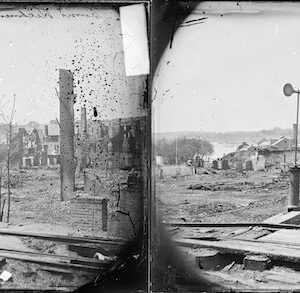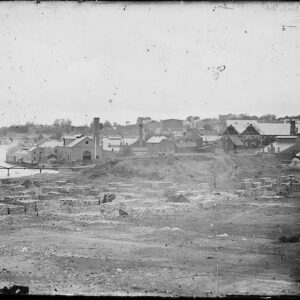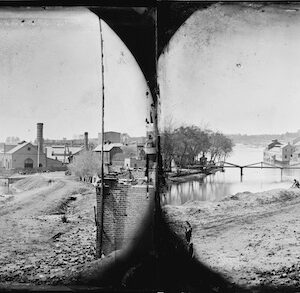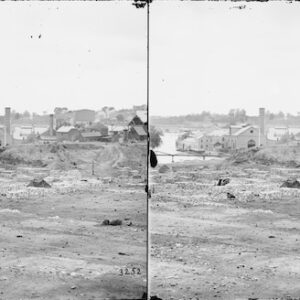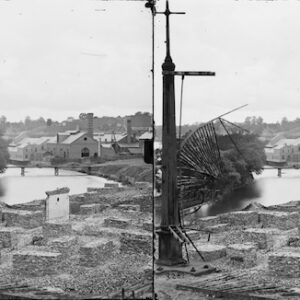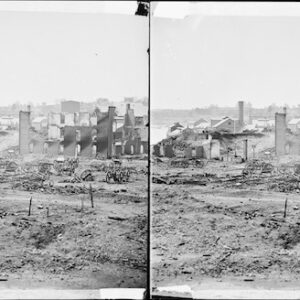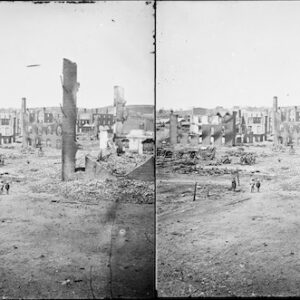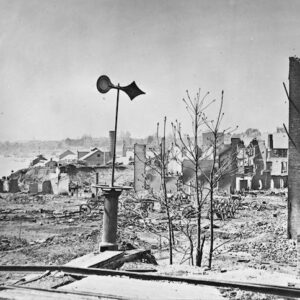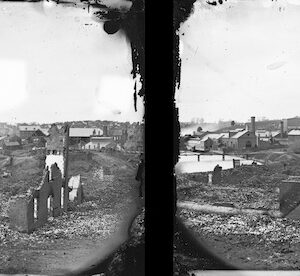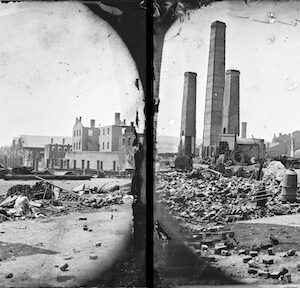Tag: Tredegar Iron Works (Richmond VA)
Wikipedia says: The Tredegar Iron Works in Richmond, Virginia, was the biggest ironworks in the Confederacy during the American Civil War, and a significant factor in the decision to make Richmond its capital.
Tredegar supplied about half the artillery used by the Confederate States Army, as well as the iron plating for CSS Virginia, the first Confederate ironclad warship, which fought in the historic Battle of Hampton Roads in March 1862. The works avoided destruction by troops during the evacuation of the city, and continued production through the mid-20th century. Now classified as a National Historic Landmark District, the site serves as the main building of the American Civil War Museum.
The name Tredegar derives from the Welsh industrial town that supplied much of the company’s early workforce.
Founding (1836–1841)
In 1836, a group of Richmond businessmen and industrialists led by Francis B. Deane, Jr. set about to capitalize on the growing railroad boom in the United States. The group hired Rhys Davies, then a young engineer, to construct a new facility, brought a number of his fellow iron workers from Tredegar, Wales, to construct the furnaces and rolling mills. The foundry was named in honor of the town of Tredegar, where iron works of the same name were constructed in the early 19th century. The new works opened in 1837, yet the Panic of 1837 and accompanying downturn resulted in hardship for the new company. Davies died in Richmond in September 1838 from stab wounds sustained in a fight with a workman and was buried on Belle Isle in the James River.
Management under Joseph Reid Anderson (1841 – Civil War)
In 1841, the owners turned management over to a 28-year-old civil engineer named Joseph Reid Anderson who proved to be an able manager. Anderson acquired ownership of the foundry in 1848, after two years of leasing the works, and was soon doing work for the United States government. Anderson began introducing slave labor to cut production costs. By the beginning of the Civil War in 1861, half of the 900 workers were slaves, including many in skilled positions. By 1860, Anderson’s father-in-law Dr. Robert Archer had joined the business and Tredegar became a leading iron producer in the country.
The commissioning of 900 miles of railroad track in Virginia, largely financed by the Virginia Board of Public Works between 1846 and 1853, offered a further market in steam locomotives and rail stock. One of those attributed with starting the Tredegar Locomotive Works with John Souther was Zerah Colburn, the well-known locomotive engineer and journalist. The company produced about 70 steam locomotives between 1850 and 1860. From 1852 to 1854, John Souther also managed the locomotive shop at Tredegar. Its locomotive production work is sometimes listed with combinations of the names Anderson, Souther, Delaney, and Pickering. Tredegar also produced the steam propulsion plants for the USS Roanoke (1855) and the USS Colorado (1856).
Prior to the Civil War, industry expanded at the Tredegar site under Anderson’s direction to include a new flour mill on land leased to Lewis D. Crenshaw and a stove works on land leased to A.J. Bowers and Asa Snyder. By 1860, Crenshaw and Co. had established the Crenshaw Woolen Mill on adjoining land they owned. This enterprise employed more than 50 people. The Crenshaw Woolen Mill became “the principal source of supply for the [Confederate] Army’s requirements of uniform material” during the first half of the Civil War. A May 16, 1863 fire on the Tredegar/Crenshaw site damaged the mill, which was not rebuilt, and Tredegar purchased the land from Crenshaw and Co. by 1863.
American Civil War
By 1860, the Tredegar Iron Works was the largest of its kind in the South, a fact that played a significant role in the decision to relocate the capital of the Confederacy from Montgomery, Alabama, to Richmond in May 1861. Tredegar supplied high-quality munitions to the Confederacy during the war.
Its wartime production included the iron plating for the first Confederate ironclad warship, the CSS Virginia which fought in the historic Battle of Hampton Roads in March 1862; credit for approximately 1,100 artillery pieces during the war, about half of the South’s total domestic production of artillery during the war years of 1861–1865, including the development of the Brooke rifle; a giant rail-mounted siege cannon. The company also manufactured railroad steam locomotives in the same period.
As a result of his difficulties competing with Northern industries due to his higher labor and raw material costs, Anderson was a strong supporter of southern secession and became a Brigadier General in the Confederate Army as the war broke out. He was wounded at Glendale during the Seven Days Battles of the Peninsula Campaign in 1862 and served in the Ordnance Department for the duration of the Civil War.
As the war continued with more and more men conscripted into the Confederate armies, Tredegar experienced a lack of skilled laborers. Scarce supplies of metal also hurt the company’s manufacturing abilities during the war and as the conflict progressed it was noticed that Tredegar’s products were beginning to lose quality as well as quantity. Even in the summer of 1861, soon after the beginning of the Civil War, metal was so scarce that the iron works failed to produce a single piece of artillery for an entire month.
During the evacuation of Richmond by the Confederates on the night of April 2–3, 1865, the retreating troops were under orders to burn munitions dumps and industrial warehouses that would have been valuable to the North. Anderson reportedly paid over 50 armed guards to protect the facility from arsonists. As a result, the Tredegar Iron Works is one of few Civil War-era buildings that survived the burning of Richmond.
Showing all 11 results
